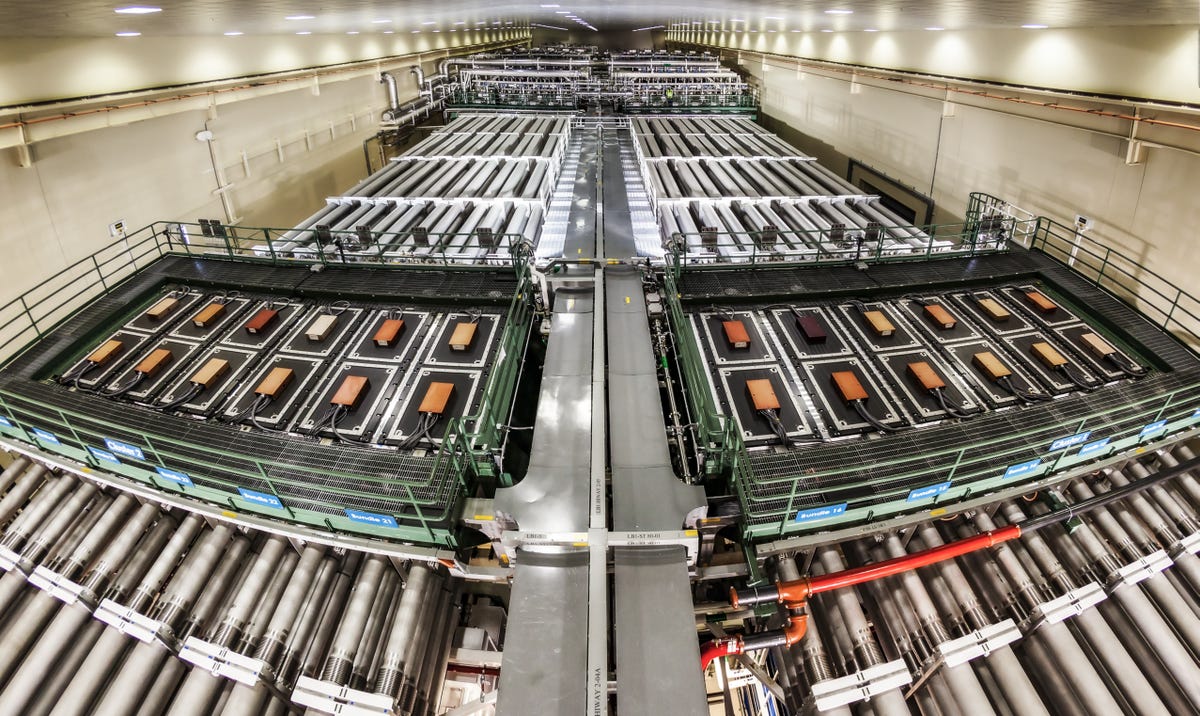Technologies
Major Energy Breakthrough: Milestone Achieved in US Fusion Experiment
For the first time, the National Ignition Facility officially achieved ignition in a fusion reactor.

It was touted as a «major scientific breakthrough» and, it seems, the rumors were true: On Tuesday, scientists at Lawrence Livermore National Laboratory announced that they have, for the first time, achieved net energy gain in a controlled fusion experiment.
«We have taken the first tentative steps toward a clean energy source that could revolutionize the world,» Jill Hruby, administrator of the National Nuclear Security Administration, said in a press conference Tuesday.
The triumph comes courtesy of the National Ignition Facility at LLNL in San Francisco. This facility has long tried to master nuclear fusion — a process that powers the sun and other stars — in an effort to harness the massive amounts of energy released during the reaction because, as Hruby points out, all that energy is «clean» energy.
Despite decades of effort, however, there had been a major kink in these fusion experiments: the amount of energy used to achieve fusion has far outweighed the energy coming out. As part of the NIF mission, scientists had long hoped to achieve «ignition,» where the energy output is «greater than or equal to laser drive energy.»
Some experts have remained skeptical that such a feat was even possible with fusion reactors currently in operation. But slowly, NIF pushed forward. In August last year, LLNL revealed it had come close to this threshold by generating around 1.3 megajoules (a measure of energy) against a laser drive using 1.9 megajoules.
But on Dec. 5, LLNL’s scientists say, they managed to cross the threshold.
They achieved ignition.
All in all, this achievement is cause for celebration. It’s the culmination of decades of scientific research and incremental progress. It’s a critical, albeit small, step forward, to demonstrate that this type of reactor can, in fact, generate energy.
«Reaching ignition in a controlled fusion experiment is an achievement that has come after more than 60 years of global research, development, engineering and experimentation,» Hruby said.
«It’s a scientific milestone,» Arati Prabhakar, policy director for the White House Office of Science and Technology, said during the conference, «but it’s also an engineering marvel.»
Still, a fully operational platform, connected to the grid and used to power homes and businesses, likely remains a few decades away.
«This is one igniting capsule at one time,» Kim Budil, director of LLNL, said. «To realize commercial fusion energy you have to do many things. You have to be able to produce many, many fusion ignition events per minute, and you have to have a robust system of drivers to enable that.»
So how did we get here? And what does the future hold for fusion energy?
Simulating stars
The underlying physics of nuclear fusion has been well understood for almost a century.
Fusion is a reaction between the nuclei of atoms that occurs under extreme conditions, like those present in stars. The sun, for instance, is about 75% hydrogen and, because of the all-encompassing heat and pressure at its core, these hydrogen atoms are squeezed together, fusing to form helium atoms.
If atoms had feelings, it would be easy to say they don’t particularly like being squished together. It takes a lot of energy to do so. Stars are fusion powerhouses; their gravity creates the perfect conditions for a self-sustaining fusion reaction and they keep burning until all their fuel — those atoms — are used up.
This idea forms the basis of fusion reactors.
Building a unit that can artificially re-create the conditions within the sun would allow for an extremely green source of energy. Fusion doesn’t directly produce greenhouse gases, like carbon dioxide and methane, which contribute to global warming.
And critically, a fusion reactor also doesn’t have the downsides of nuclear fission, the splitting of atoms used in nuclear bombs and reactors today.
In other words, a fusion power plant wouldn’t produce the radioactive waste associated with nuclear fission.
The big fusion experiment
The NIF, which takes up the space of around three football fields at LLNL, is the most powerful «inertial confinement fusion» experiment in the world.
In the center of the chamber lies a target: a «hohlraum,» or cylinder-shaped device that houses a tiny capsule. The capsule, about as big as a peppercorn, is filled with isotopes of hydrogen, deuterium and tritium, or D-T fuel, for short. The NIF focuses all 192 lasers at the target, creating extreme heat that produces plasma and kicks off an implosion. As a result, the D-T fuel is subject to extreme temperatures and pressures, fusing the hydrogen isotopes into helium — and a consequence of the reaction is a ton of extra energy and the release of neutrons.
You can think of this experiment as briefly simulating the conditions of a star.
The complicated part, though, is that the reaction also requires a ton of energy to start. Powering the entire laser system used by the NIF requires more than 400 megajoules — but only a small percentage actually hits the hohlraum with each firing of the beams. Previously, the NIF had been able to pretty consistently hit the target with around 2 megajoules from its lasers.
But on Dec. 5, during one run, something changed.
«Last week, for the first time, they designed this experiment so that the fusion fuel stayed hot enough, dense enough and round enough for long enough that it ignited,» Marv Adams, deputy administrator at the NNSA, said during the conference. «And it produced more energy than the lasers had deposited.»
More specifically, scientists at NIF kickstarted a fusion reaction using about 2 megajoules of energy to power the lasers and were able to get about 3 megajoules out. Based on the definition of ignition used by NIF, the benchmark has been passed during this one short pulse.
You might also see that energy gain in a fusion reaction is denoted by a variable, Q.
Like ignition, the Q value can refer to different things for different experiments. But here, it’s referring to the energy input from the lasers versus the energy output from the capsule. If Q = 1, scientists say they have achieved «breakeven,» where energy in equals energy out.
The Q value for this run, for context, was around 1.5.
In the grand scheme of things, the energy created with this Q value is only about enough to boil water in a kettle.
«The calculation of energy gain only considers the energy that hit the target, and not the [very large] energy consumption that goes into supporting the infrastructure,» said Patrick Burr, a nuclear engineer at the University of New South Wales.
The NIF is not the only facility chasing fusion — and inertial confinement is not the only way to kickstart the process. «The more common approach is magnetically confined fusion,» said Richard Garrett, senior advisor on strategic projects at the Australian Nuclear Science and Technology Organization. These reactors use magnetic fields to control the fusion reaction in a gas, typically in a giant, hollow donut reactor known as a tokamak.
Those devices have a much lower density than NIF’s pellets, so temperatures need to be increased to well over 100 million degrees. Garrett said he does not expect the NIF result to accelerate tokamak fusion programs because, fundamentally, the two processes work quite differently.
However, significant progress is also being made with magnetically confined fusion. For instance, the ITER experiment, under construction in France, uses a tokamak and is expected to begin testing in the next decade. It has lofty goals, aiming to achieve a Q greater than 10 and to develop commercial fusion by 2050.
The future of fusion
The experiment at NIF might be transformative for research, but it won’t immediately translate to a fusion energy revolution. This isn’t a power-generating experiment. It’s a proof of concept.
This is a point worth paying attention to today, especially as fusion has often been touted as a way to combat the climate crisis and reduce reliance on fossil fuels or as a salve for the world’s energy problems. Construction and utilization of fusion energy to power homes and businesses is still a ways off — decades, conservatively — and inherently reliant on technological improvements and investment in alternative energy sources.
Generating around 2.5 megajoules of energy when the total input from the laser system is well above 400 megajoules is, of course, not efficient. And in the case of the NIF experiment, it was one short pulse.
Looking further ahead, constant, reliable, long pulses will be required if this is to become sustainable enough to power kettles, homes or entire cities.
«It’s unlikely that fusion power … will save us from climate change,» said Ken Baldwin, a physicist at the Australian National University. If we are to prevent the largest increases in global average temperature, fusion power is likely going to be a little too late.
Other investment is going to come from private companies, which are seeking to operate tokamak fusion reactors in the next few years. For instance, Tokamak Energy in the UK is building a spherical tokamak reactor and seeks to hit breakeven by the middle of this decade.
Then there’s Commonwealth Fusion Systems, spun out of MIT, which is hoping to generate around 400 megawatts of power, enough for tens of thousands of homes, by the 2030s. Modern nuclear power plants can produce almost three times as much.
And as CNET editor Stephen Shankland noted in a recent piece, fusion reactors will also need to compete against solar and wind power — so even with today’s revelatory findings, fusion energy remains entrenched in the experimental phase of its existence.
But we can now cast one eye toward the future.
It may not prevent the worst of climate change but, harnessed to its full potential, it could produce a near-limitless supply of energy for generations to come. It’s one thing to think about the future of energy on Earth and how it will be utilized, but our eyes may fall on horizons even further out — deep space travel could utilize fusion reactors that blast us well beyond the reaches of our sun’s gravity, the very thing that helped teach us about fusion reactions, and into interstellar space.
Perhaps then, we’d remember Dec. 5, 2022, as the first tiny step toward places we dared once only dream about.
Correction, 8:44 a.m. PT: This article initially misstated the amount of energy in the fusion reaction. NIF powered the lasers with about 2 megajoules and produced 3 megajoules as a result.
Technologies
Today’s NYT Strands Hints, Answers and Help for Jan. 9 #677
Here are hints and answers for the NYT Strands puzzle for Jan. 9, No. 677.

Looking for the most recent Strands answer? Click here for our daily Strands hints, as well as our daily answers and hints for The New York Times Mini Crossword, Wordle, Connections and Connections: Sports Edition puzzles.
Today’s NYT Strands puzzle is a fun topic — but one of the answers describes something I’ve never heard of before. Also, some of the answers are difficult to unscramble, so if you need hints and answers, read on.
I go into depth about the rules for Strands in this story.
If you’re looking for today’s Wordle, Connections and Mini Crossword answers, you can visit CNET’s NYT puzzle hints page.
Read more: NYT Connections Turns 1: These Are the 5 Toughest Puzzles So Far
Hint for today’s Strands puzzle
Today’s Strands theme is: For cubs fans.
If that doesn’t help you, here’s a clue: Like Gentle Ben.
Clue words to unlock in-game hints
Your goal is to find hidden words that fit the puzzle’s theme. If you’re stuck, find any words you can. Every time you find three words of four letters or more, Strands will reveal one of the theme words. These are the words I used to get those hints but any words of four or more letters that you find will work:
- LAIR, RAIL, CROP, LAID, BALD, DEAN, BROW, DIZZY
Answers for today’s Strands puzzle
These are the answers that tie into the theme. The goal of the puzzle is to find them all, including the spangram, a theme word that reaches from one side of the puzzle to the other. When you have all of them (I originally thought there were always eight but learned that the number can vary), every letter on the board will be used. Here are the nonspangram answers:
- BLACK, BROWN, GRIZZLY, PANDA, POLAR, SPECTACLED (That last one is the one I’ve never heard of! But it’s real!)
Today’s Strands spangram
Today’s Strands spangram is BEARSINMIND. To find it, start with the B that’s five rows to the right and three letters down, then wind up, over and down the whole far-right row.
Don’t miss any of our unbiased tech content and lab-based reviews. Add CNET as a preferred Google source.
Toughest Strands puzzles
Here are some of the Strands topics I’ve found to be the toughest.
#1: Dated slang. Maybe you didn’t even use this lingo when it was cool. Toughest word: PHAT.
#2: Thar she blows! I guess marine biologists might ace this one. Toughest word: BALEEN or RIGHT.
#3: Off the hook. Again, it helps to know a lot about sea creatures. Sorry, Charlie. Toughest word: BIGEYE or SKIPJACK.
Technologies
Today’s NYT Mini Crossword Answers for Friday, Jan. 9
Here are the answers for The New York Times Mini Crossword for Jan. 9.

Looking for the most recent Mini Crossword answer? Click here for today’s Mini Crossword hints, as well as our daily answers and hints for The New York Times Wordle, Strands, Connections and Connections: Sports Edition puzzles.
Need some help with today’s Mini Crossword? The Across clues were kind of tough today. Read on for all the answers. And if you could use some hints and guidance for daily solving, check out our Mini Crossword tips.
If you’re looking for today’s Wordle, Connections, Connections: Sports Edition and Strands answers, you can visit CNET’s NYT puzzle hints page.
Read more: Tips and Tricks for Solving The New York Times Mini Crossword
Let’s get to those Mini Crossword clues and answers.
Mini across clues and answers
1A clue: Question in a late-night text
Answer: YOUUP
6A clue: Plentiful
Answer: AMPLE
7A clue: Saint ___ and Nevis (Caribbean nation)
Answer: KITTS
8A clue: Baby-bringing bird
Answer: STORK
9A clue: Take care of the tab
Answer: PAY
Mini down clues and answers
1D clue: Himalayan herbivores
Answer: YAKS
2D clue: Fail to include
Answer: OMIT
3D clue: «High five!»
Answer: UPTOP
4D clue: The «U» of UV rays
Answer: ULTRA
5D clue: Annoying to deal with
Answer: PESKY
Don’t miss any of our unbiased tech content and lab-based reviews. Add CNET as a preferred Google source.
Technologies
I Got Up Close and Personal With Boston Dynamics’ New Atlas Robot
Before Atlas takes its first steps into the world of work later this year, I found myself face-to-face with CES 2026’s most talked-about robot on the show floor.

When I say that I went hands-on with the new Boston Dynamics Atlas robot, I mean that I actually held hands with it. This humanoid robot, which CNET just awarded the Best Robot of CES Award, is one of the most advanced in the world, and I couldn’t pass up the opportunity to get up close and personal with it.
This product version of the robot, which is set to be shipped to Hyundai factories imminently to start working, has been the talk of CES this year. The specific Atlas robot I encountered was a static model that wasn’t turned on or fully operational. Our interactions were, therefore, sadly one-sided. Still, I ran my hands over its soft-touch plastic shell and gently prodded at its finger joints, wondering how it would feel if they gripped me back.
People tend to have varying feelings about humanoid robots — understandable given that they are built to some degree in our image, while also usually being stronger than us, with «brains» that we don’t fully understand. Atlas definitely evokes contradictory emotions for me — even more so when I stood face-to-face with it.
I’m in awe of the engineering, a little fearful of its capabilities, hesitant about what it could mean for the future of humanity and charmed by its design and styling. The periwinkle blue iteration of Atlas that I met on the show floor at CES 2026 almost bears more resemblance to a Dyson product than it does the industrial robots that defined Boston Dynamics’ early days, when it was best known for its work with DARPA.
«There’s a lot of really specific things about this robot that probably look a little weird,» said Zachary Jackowski, Boston Dynamics VP and general manager of Atlas. He pointed to the legs, which he described as «like nothing anyone else was doing.»
Atlas’ thighs are narrow set and in line with the torso, while the calves are wider set, attached to their upper counterparts with a circular joint. This robot is, in fact, all subtle curves and soft lines. There are no harsh edges or stark angles.
During a year when CES has been flooded with humanoid robots, Atlas definitely does stand out due to its design. It appears both less classically human and less industrial than some of its peers, while also lacking the often intimidating, featureless faces they tend to exhibit. Instead, it has two low-set cameras resembling eyes placed where you’d usually expect a mouth to be. Its face is a perfect flat circle, defined by an LED halo that gives it a somewhat Pixar lamp effect.
I asked Jackowski why Boston Dynamics decided to skew so relatively unhuman with this version of its humanoid. «Well, it’s not a human,» he said. «It projects the wrong first impression about a robot to have it pretend to be something that it’s not.»
Particularly in the early days of humanoids, he added, robots won’t have anything like human-like intelligence. People should look at it and see it for what it is — a tool for performing tasks safely and efficiently.
In fact, most of the design decisions were made to keep Atlas as simple, scalable and safe as possible, Jackowski said. I remark that there’s some irony in thinking of a humanoid robot as simple, given the complexity of the technology and development process to bring Atlas to life.
The key to making it simple, Jackowski said, is having a strong enough grasp of the technology to «accomplish the complex thing of building a humanoid robot,» but then being able to take it apart and understand that you can use fewer computers and actuators in it while achieving the same results.
And it’s essential to Boston Dynamics that Atlas is perceived as simple. After all, it’s a general-purpose humanoid, which might eventually be sent far and wide to fulfil all manner of roles. Jackowski calls it the «ultimate generalist.»
Simplicity aside, there are aspects of Atlas that Jackowski believes set it apart from other humanoids at the show. «The repairability of this robot is crazy good,» he said. «The runtime is crazy good. The strength is unlike anything.»
From working in Hyundai’s manufacturing plants, Atlas’s job trajectory is to eventually graduate to many of the same industrial environments where Boston Dynamics’ Spot robot works, before moving to bussing tables in the service industry and eventually into the home. The robot will evolve between now and then, Jackowski said. However, this could be an early glimpse of the type of humanoid that will eventually be our housemate.
That’s some way away, though, which is probably for the best. As I gaze up at Atlas, which I’d guess is around the same height as my husband, my feeling is that, however impressive Atlas is, I’m still not ready for it to move in.
-

 Technologies3 года ago
Technologies3 года agoTech Companies Need to Be Held Accountable for Security, Experts Say
-

 Technologies3 года ago
Technologies3 года agoBest Handheld Game Console in 2023
-

 Technologies3 года ago
Technologies3 года agoTighten Up Your VR Game With the Best Head Straps for Quest 2
-

 Technologies4 года ago
Technologies4 года agoBlack Friday 2021: The best deals on TVs, headphones, kitchenware, and more
-

 Technologies4 года ago
Technologies4 года agoGoogle to require vaccinations as Silicon Valley rethinks return-to-office policies
-

 Technologies4 года ago
Technologies4 года agoVerum, Wickr and Threema: next generation secured messengers
-

 Technologies4 года ago
Technologies4 года agoOlivia Harlan Dekker for Verum Messenger
-

 Technologies4 года ago
Technologies4 года agoiPhone 13 event: How to watch Apple’s big announcement tomorrow
